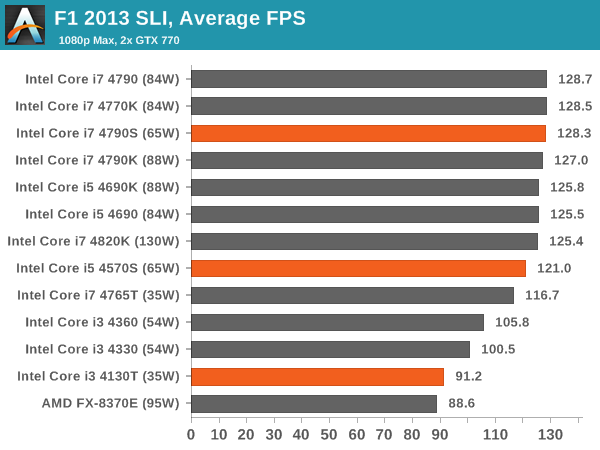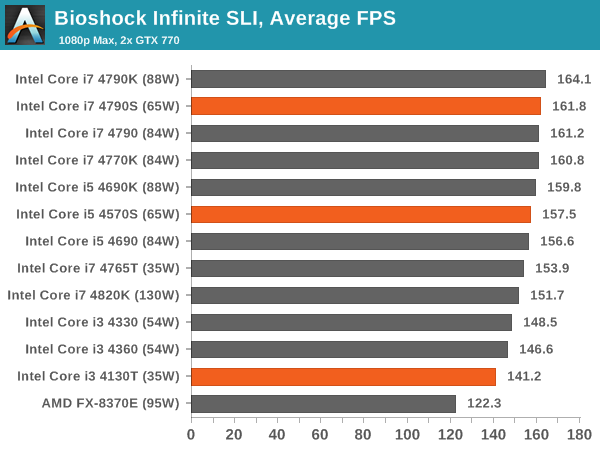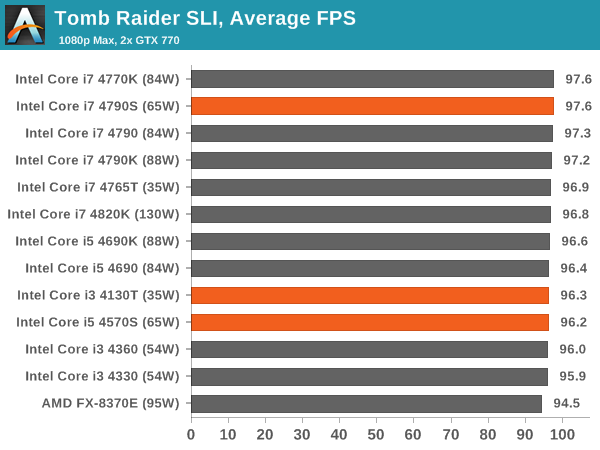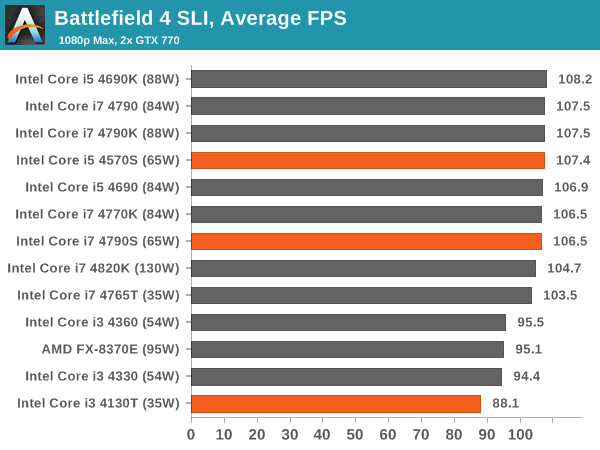Intel Haswell Low Power CPU Review: Core i3-4130T, i5-4570S and i7-4790S Tested
by Ian Cutress on December 11, 2014 10:00 AM ESTGaming Benchmarks on GTX 770
F1 2013
First up is F1 2013 by Codemasters. I am a big Formula 1 fan in my spare time, and nothing makes me happier than carving up the field in a Caterham, waving to the Red Bulls as I drive by (because I play on easy and take shortcuts). F1 2013 uses the EGO Engine, and like other Codemasters games ends up being very playable on old hardware quite easily. In order to beef up the benchmark a bit, we devised the following scenario for the benchmark mode: one lap of Spa-Francorchamps in the heavy wet, the benchmark follows Jenson Button in the McLaren who starts on the grid in 22nd place, with the field made up of 11 Williams cars, 5 Marussia and 5 Caterham in that order. This puts emphasis on the CPU to handle the AI in the wet, and allows for a good amount of overtaking during the automated benchmark. We test at 1920x1080 on Ultra graphical settings.

Bioshock Infinite
Bioshock Infinite was Zero Punctuation’s Game of the Year for 2013, uses the Unreal Engine 3, and is designed to scale with both cores and graphical prowess. We test the benchmark using the Adrenaline benchmark tool and the Xtreme (1920x1080, Maximum) performance setting, noting down the average frame rates and the minimum frame rates.

Tomb Raider
The next benchmark in our test is Tomb Raider. Tomb Raider is an AMD optimized game, lauded for its use of TressFX creating dynamic hair to increase the immersion in game. Tomb Raider uses a modified version of the Crystal Engine, and enjoys raw horsepower. We test the benchmark using the Adrenaline benchmark tool and the Xtreme (1920x1080, Maximum) performance setting, noting down the average frame rates and the minimum frame rates.

Sleeping Dogs
Sleeping Dogs is a benchmarking wet dream – a highly complex benchmark that can bring the toughest setup and high resolutions down into single figures. Having an extreme SSAO setting can do that, but at the right settings Sleeping Dogs is highly playable and enjoyable. We run the basic benchmark program laid out in the Adrenaline benchmark tool, and the Xtreme (1920x1080, Maximum) performance setting, noting down the average frame rates and the minimum frame rates.

Battlefield 4
The EA/DICE series that has taken countless hours of my life away is back for another iteration, using the Frostbite 3 engine. AMD is also piling its resources into BF4 with the new Mantle API for developers, designed to cut the time required for the CPU to dispatch commands to the graphical sub-system. For our test we use the in-game benchmarking tools and record the frame time for the first ~70 seconds of the Tashgar single player mission, which is an on-rails generation of and rendering of objects and textures. We test at 1920x1080 at Ultra settings.
















76 Comments
View All Comments
patrickjchase - Friday, December 12, 2014 - link
I used to work on SoCs in process nodes down to 28 nm, and the variation from the fast/fast (low-delay, leaky) to the slow/slow (high-delay, low-leakage) corners in modern processes is substantial. The fact that a given vendor isn't binning simply means that they're adding a fair bit of margin.For that matter I wouldn't be so sure that Apple doesn't bin. For example it's possible that the A7s in iPhone 5s and iPad Air were binned differently.
Finally, Intel's volumes create additional binning opportunities. A process condition that happens, say, 0.1% of time time would constitute such as small volume as to be useless to most vendors but adds up to a nice niche for Intel.
aj654987 - Friday, May 15, 2015 - link
I think its reasonable to believe they are binned. From a business perspective, is it really necessary to have THAT many different CPU models that Intel has? At some point you can have too many products and theyre competing with each other. Look at GM and how they had too many brands and rebadged vehicles that are competing with each other. I dont think there IS any business advantage to artificially create as many different chip models as intel has, though there is a business advantage to being able to salvage chips they would otherwise have to toss.When comparing to ARM processors, those are less complex and less expensive. If they have an ARM chip that tests bad, it may make more sense to toss it then to cripple it and sell it as a lower model. Also like consoles there is a preference to have the same speed across all devices, where as with a PC, different CPU speeds seem more acceptable to the market.
eanazag - Thursday, December 11, 2014 - link
The 65W parts seemed to show increased performance in IGP gaming versus their non-S counterparts. 4790S vs 4790. I would suspect the TDP budget for the IGP is unaffected by the TDP reduction and therefore might get a little thermal room to run harder. Looking at Intel ARK the 4790 series all runs at 350 base and 1.2 max; the 4790K is able to boost higher to 1.25GHz. The IGP gaming number seem to tell this story.You can also see when a discrete GPU is thrown in there the non-S parts then perform above the S parts in gaming.
For IGP gaming AMD is still the best choice; and that is about all they're good for.
evilspoons - Friday, December 12, 2014 - link
This is the story in thermally-limited situations like the Surface Pro 3. The i5 model is faster at games than the i7 simply because the i5's CPU uses less of the thermal budget so the iGPU can stay faster for longer. In a more extreme case, running old non-CPU bound games (World of Warcraft), the i3 model is even better - the CPU leaves even more room for the iGPU.Of course, this could all be avoided by the game simply going "hmm, which one is really slowing me down - the CPU loop or the GPU loop?" and then throttling one to match, but the odds of that happening any time soon are pretty poor.
mortenelkjaer - Friday, December 12, 2014 - link
IGP gaming, What is that?MrSpadge - Thursday, December 11, 2014 - link
No. The regular Intel 22 nm CPUs are so good that they can run ~4.0 GHz at ~1.0 V, whereas stock gives them almost 1.2 V at the top turbo bin. So cutting down on power consumption hardly requires any effort.Samus - Thursday, December 11, 2014 - link
Eventually wear and leakage will cause tapering. The long-term reliability is Intel's goal which is why these chips are so conservatively clocked. I've already read reports of people running Haswell at 1.3V that initially had them stable at 4.6+GHz and a year later, can't crack 4.2GHz at 1.2V.Keeping these things around 1.0V is key to their service life. As Spadge said, try to get the most you can out of the stock voltage (usually 4GHz, sometimes more.)
B3an - Thursday, December 11, 2014 - link
Completely off topic, but you guys do an article on AMD's new "Omega" driver? It has loads of new features and i can't find anywhere that's done a proper in-depth article on it.DiHydro - Thursday, December 11, 2014 - link
The Tech Report, and PCPer both have articles about the features and performance gains of the Omega driver release.JarredWalton - Thursday, December 11, 2014 - link
It's in the works. Ryan and I both were out for a few days due to illness, unfortunately.